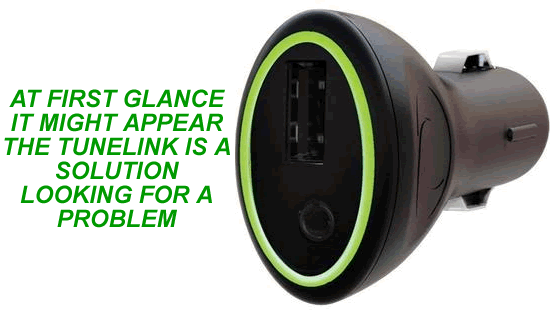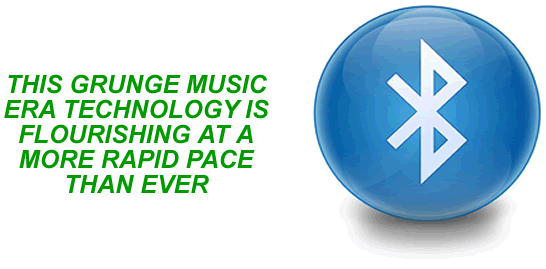New Potato Tunelink for Android Review: Party like it’s 2003
New Potato Tunelink for Android Review: Party like it’s 2003
by ShanMan14
The more things change, the more things change. The 90’s boasted the mindscape that birthed technological gems such as the digital answering machine and the Pentium processor. Such tech of that bygone era may have vanished into irrelevancy but not all 90’s tech is so immaterial. It’s because of that, roughly a decade later, we are talking about Bluetooth.
Purchasing a gadget to provide Bluetooth connectivity in your vehicle might appear redundant if you’ve perused the new car lot recently. Over 50% of the vehicles sold in 2012 offer it as either standard equipment or at least as part of an option package. This grunge music era technology is flourishing at a more rapid pace than ever, ostensibly due to the proliferation of smart phones, but more on that later.
Despite the numbers, Bluetooth is far from breaching the realm of standard equipment when it comes to automobiles sans recent model years. Lest we forget those who opted out of the $3000 equipment group that gained Bluetooth functionality when they purchased the new family minivan, or simply the rest of us motoring around in perfectly adequate older vehicles. And, there are a fair number of techno-phobes out there who simply don’t know what Bluetooth is or how it can benefit them. To that end, allow us to educate you.
WHAT IS BLUETOOTH?
So, what is Bluetooth and why do you need it? Bluetooth is simply a short-range radio technology that provides wireless transmission of data and/or audio signals. Two Bluetooth enabled devices such as a cell phone and automobile are ?paired? allowing this communication. The iPad keyboard you (might) own uses Bluetooth technology to work. The range can be anywhere from 3 to 300 feet.

As with many technology ‘standards? the landscape evolves and Bluetooth is no different. While it’s true the first MP3 player featuring Bluetooth technology appeared in 2003, the implementation into automobiles was primarily for the purposes of hand-free cell phone conversations. Early versions of Bluetooth were ill equipped to handle the bit rates (speeds) necessary for a quality audio transmission we demand today. More modern versions of Bluetooth such as the Bluetooth Advanced Audio Distribution Profile (A2DP) seek to remedy this quandary.
MOBILE TECH BLOSSOMS
When Apple released the iPhone in 2007 it changed the mobile landscape. Your phone was just not a phone anymore; it became a music player, too, overnight. Future iterations of the iPhone allowed access to faster 3G cellular data networks and now even faster Long Term Evolution (LTE) or ?4G? data networks.
At the same time, music streaming services such as Pandora, Spotify, and RDO took a foothold on the desktop and bled to the mobile space. Google and Amazon allow you to upload your own music to their ?cloud? servers and stream via your mobile device. Today you have unprecedented access to data networks and the methods with which you can ?consume? data are boundless.
BRIDGE TO SOMEWHERE
Most likely you replace your mobile phone more frequently than your car. The lifecycle of a current mobile phone is typically less than the two year contract you signed when you purchased the device. If we could only update our vehicles as frequently?
So, how do you harness this reborn technology in your iPhone or Android phone with an old 2005 jalopy that doesn’t have Bluetooth? Solution: New Potato Technologies TuneLink Auto Bluetooth Audio Adapter.
The TuneLink serves one purpose: to play your mobile device audio output through your vehicle’s speakers, specifically music. It accomplishes this through one of two ways: Directly wired using the included 3.5mm audio cable or via FM transmission. While your 2005 Honda might not have Bluetooth, it’s very likely it has an AUX input. The TuneLink leverages this feature for a crystal clear input to your stereo using the aforementioned A2DP protocol between it and your mobile device.
The second method is using the built-in FM transmitter. We consider this a backup as the audio quality is diminished using this method and it’s highly susceptible to interference. But, in a pinch, it has the capability to be functional.
Setup was quite easy, as Bluetooth should be. We sent several staffers out with the TuneLink device, their Android phones, the cables and nothing else but their pride. After our unscientific test, we are confident a child can accomplish the setup! Each achieved a 100% success rate in our exam with an average of about 90 seconds to pair devices. It really is quite simple.
Akin to some technology mating ritual, once the TuneLink bulb is inserted into the power outlet the Hulkish green hue illuminating from the device indicates it’s ready to pair. The device is now transmitting its ?TUNELINK? name and from your Android device you connect, or pair, the two. The courtship ritual is complete as indicated by the TuneLink audaciously flashing its LED, with pride.
SOFTWARE
New Potato offers the TuneLink app from the Google Play Store. In our testing, if you’re connecting using the 3.5mm jack, the software is unnecessary. Bluetooth doesn’t need the app to function and in fact the settings portion of the TuneLink app will direct you to the native Android OS Bluetooth configuration. The TuneLink app is far from bloatware, though. If you are forced to use the FM transmitter, you can’t select the frequency without it.
The TuneLink app attempts to make selecting a frequency easier by suggesting the least interference prone frequencies and rates them using a star system, a nice touch. This ?Speedtune? feature is great if you’re on the move as the best frequency changes based on location, so you’ll appreciate this feature a lot.
LIVING WITH THE TUNELINK
As mentioned above in our staff test, we tried several Android devices with our Tunelink, all paired relatively painlessly. In our extended testing there were times, inexplicably, where the devices refused to link up. We remedied the situation by either toggling the Bluetooth on the mobile device or unplugging and plugging back in the TuneLink. One of these two worked 100% of the time.
Audio quality differences between a wired connection and the TuneLink Bluetooth connection were imperceptible to most staffers in our very unscientific blindfold test. We played everything from Pearl Jam to Mozart and even talk radio, i.e. “podcasts.” Of course a large component to audio reproduction quality is dependent on your vehicle sound system, but there were no complaints in our test vehicles. Sprinkle in some road noise and we?d venture to guess few would be able to discern the source; perhaps even an audiophile?
If you’re crafty enough, you can preset your device to the audio output of your choice prior to the TuneLink pairing. When your device pairs with it, the audio will automatically start using that audio output. For instance, as you approach your vehicle, launch an app like Pandora or Google Music. When you turn the car on and the devices pair, Pandora or Google Music will play seamlessly through your car audio system without you having to do anything. We liked this, a lot.
One strange byproduc
t we did experience is the audio automatically playing, but from a source we didn’t want. When we didn’t preset our audio output (such as Pandora or Spotify in the preceding paragraph), Google Music would start after the pairing process; but not always. It seems, in our test cases, Google Music always took precedent over other audio outputs. The player will resume the last song playing, where it left off. This seems more a function or ?feature? of the Android device and not so much the TuneLink.
t we did experience is the audio automatically playing, but from a source we didn’t want. When we didn’t preset our audio output (such as Pandora or Spotify in the preceding paragraph), Google Music would start after the pairing process; but not always. It seems, in our test cases, Google Music always took precedent over other audio outputs. The player will resume the last song playing, where it left off. This seems more a function or ?feature? of the Android device and not so much the TuneLink.

Further, after turning the power off to the TuneLink, effectively severing the ?pair,? the music or podcast continued to play; at least for a little while. So, while it starts on its own you have to consciously pause or stop the audio or you will lose you place by about 30 seconds. That was a little frustrating, particularly when playing a podcast.
This was an additional ?gotcha? for which you must pay particular attention. If your car stereo is off but the Tunelink powered on, the devices will still pair and start playing. You could, inadvertently, consume large amounts of data over your 3G or 4G connection and not realize it.
If you’re a podcast listener, rejoice. Audio reproduction, here, is great. With talk radio, the long pauses or silences can be burdened by whine and hum from the alternator due to an unshielded or poorly grounded accessory, particularly those that integrate in to the sound system. We’re happy to report the TuneLink does not suffer from this annoying issue.
To that end, another asset to the TuneLink is its ability to charge devices. Our version included a micro-USB charging cable that plugs into the isolated USB port of the Tunelink. This will charge your Android phone or any device that accepts micro-USB charging. The port was more than adequate for our Android phone test group: Galaxy Nexus, Razr and HTC Nexus 1. The USB port is 5 VDC, 2.1 so tablets and other more power hungry devices may experience longer charge times if you choose to attach them.
FLAVORS
There are actually two flavors of TuneLink, one marketed to the Android market and one to the iPhone market. How these differ, technologically is not entirely clear short of the change to a blue light on the iPhone model.
Our initial test was with the iPhone version which claims to work with both iPhone and Android devices. After some frustrating experiences using the Apple model with our Android devices, the company graciously offered to replace it with the Android version. Since 75% of our test phones were Android, we probably should have just gone for the Android model in the first place.
It’s important to note, the iPhone model worked flawlessly in our iPhone 4 test, it was only our Android devices and the iPhone marketed TuneLink that balked. Bottom line, buy the version for your device.
Neither style will operate as a hand-free phone, the TuneLink does not have a microphone. Though, chances are if you are using your phone this way now you probably already have a solution to listening to your music. But, don’t buy the TuneLink expecting it to operate as a hand-free phone.
CONCLUSION
At first glance it might appear the TuneLink is a solution looking for a problem, when it fact it solves a major technology gap most of us didn’t know we had. For about $100 it represents a quick and easy method to gain easy access to our music and podcasts. It’s portable, small and easy to work with.
We really enjoyed our time with the TuneLink. It appears to be a relatively simple solution to bring your auto in the mobile revolution without having to spend a lot of dough. The auto-start feature is convenient with the caveats we mentioned, as is the automatic pairing; just be mindful of the fact the devices pair regardless of whether your stereo volume is on.
If you’re looking for an almost seamless integration experience between your mobile device and your mobility, we don’t think you can go wrong, here.
